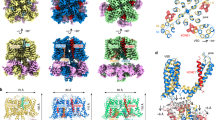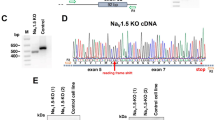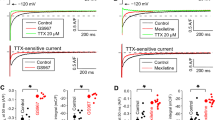Abstract
Aim:
To compare the effects of two stereoisomeric forms of glycyrrhetinic acid on different components of Na+ current, HERG and Kv1.5 channel currents.
Methods:
Wild-type (WT) and long QT syndrome type 3 (LQT-3) mutant ΔKPQ Nav1.5 channels, as well as HERG and Kv1.5 channels were expressed in Xenopus oocytes. In addition, isolated human atrial myocytes were used. Two-microelectrode voltage-clamp technique was used to record the voltage-activated currents.
Results:
Superfusion of 18β-glycyrrhetinic acid (18β-GA, 1–100 μmol/L) blocked both the peak current (INa,P) and late current (INa,L) generated by WT and ΔKPQ Nav1.5 channels in a concentration-dependent manner, while 18α-glycyrrhetinic acid (18α-GA) at the same concentrations had no effects. 18β-GA preferentially blocked INa,L (IC50=37.2±14.4 μmol/L) to INa,P (IC50=100.4±11.2 μmol/L) generated by ΔKPQ Nav1.5 channels. In human atrial myocytes, 18β-GA (30 μmol/L) inhibited 47% of INa,P and 87% of INa,L induced by Anemonia sulcata toxin (ATX-II, 30 nmol/L). Superfusion of 18β-GA (100 μmol/L) had no effects on HERG and Kv1.5 channel currents.
Conclusion:
18β-GA preferentially blocked the late Na current without affecting HERG and Kv1.5 channels.
Similar content being viewed by others
Log in or create a free account to read this content
Gain free access to this article, as well as selected content from this journal and more on nature.com
or
References
Noble D, Noble PJ . Late sodium current in the pathophysiology of cardiovascular disease: consequences of sodium-calcium overload. Heart 2006; 92: v1–v5.
Hale SL, Shryock JC, Belardinelli L, Sweeney M, Kloner RA . Late sodium current inhibition as a new cardioprotective approach. J Mol Cell Cardiol 2008; 44: 954–67.
Morita N, Lee JH, Xie Y, Sovari A, Qu Z, Weiss J N, et al. Suppression of re-entrant and multifocal ventricular fibrillation by the late sodium current blocker ranolazine. J Am Coll Cardiol 2011; 57: 366–75.
Shryock JC, Belardinelli L . Inhibition of late sodium current to reduce electrical and mechanical dysfunction of ischaemic myocardium. Br J Pharmacol 2008; 153: 1128–32.
Antzelevitch C, Burashnikov A, Sicouri S, Belardinelli L . Electrophysiologic basis for the antiarrhythmic actions of ranolazine. Heart Rhythm 2011; 8: 1281–90.
Jacobshagen C, Belardinelli L, Hasenfuss G, Maier LS . Ranolazine for the treatment of heart failure with preserved ejection fraction: background, aims, and design of the RALI-DHF study. Clin Cardiol 2011; 34: 426–32.
Conti CR . Ion channel therapy of ischemic heart disease: from calcium channel blockers to late sodium current inhibition. Clin Cardiol 2011; 34: 66–7.
Witchel HJ . Drug-induced hERG block and long QT syndrome. Cardiovasc Ther 2011; 29: 251–9.
Nerbonne JM . Molecular basis of functional voltage-gated K+ channel diversity in the mammalian myocardium. J Physiol 2000; 525: 285–98.
Fedida D, Wible B, Wang Z, Fermini B, Faust F, Nattel S, et al. Identity of a novel delayed rectifier current from human heart with a cloned K+ channel current. Circ Res 1993; 73: 210–6.
Nielsen NH, Winkel BG, Kanters JK, Schmitt N, Hofman-Bang J, Jensen HS, et al. Mutations in the Kv1.5 channel gene KCNA5 in cardiac arrest patients. Biochem Biophys Res Commun 2007; 354: 776–82.
Fiore C, Eisenhut M, Ragazzi E, Zanchin G, Armanini D . A history of the therapeutic use of liquorice in Europe. J Ethnopharmacol 2005; 99: 317–24.
Du Y, Zhang S, Wu H, Zou A, Lei M, Cheng L, et al. Glycyrretinic acid blocks cardiac sodium channels expressed in Xenopus oocytes. J Ethnopharmacol 2009; 125: 318–23.
Wang ZY, Agarwal R, Zhou ZC, Bickers DR, Mukhtar H . Inhibition of mutagenicity in Salmonella typhimurium and skin tumor initiating and tumor promoting activities in SENCAR mice by glycyrrhetinic acid: comparison of 18 alpha- and 18 beta-stereoisomers. Carcinogenesis 1991; 12: 187–92.
Du YM, Zhang XX, Tu DN, Zhao N, Liu YJ, Xiao H, et al. Molecular determinants of Kv1.5 channel block by diphenyl phosphine oxide-1. J Mol Cell Cardiol 2010; 48: 1111–20.
Tu DN, Liao YH, Zou AR, Du YM, Run Q, Wang XP, et al. Electropharmacological properties of telmisartan in blocking hKv1.5 and HERG potassium channels expressed on Xenopus laevis oocytes. Acta Pharmacol Sin 2008; 29: 913–22.
Xiao H, Wang M, Du Y, Yuan J, Zhao G, Tu D, et al. Agonist-like autoantibodies against calcium channel in patients with dilated cardiomyopathy. Heart Vessels 2011. doi: 10.1007/s00380-011-0176-7.
Rajamani S, El-Bizri N, Shryock JC, Makielski JC, Belardinelli L . Use-dependent block of cardiac late Na+ current by ranolazine. Heart Rhythm 2009; 6: 1625–31.
Sheets MF, Fozzard HA, Lipkind GM, Hanck DA . Sodium channel molecular conformations and antiarrhythmic drug affinity. Trends Cardiovasc Med 2010; 20: 16–21.
Gintant GA, Hoffman BF . Use-dependent block of cardiac sodium channels by quaternary derivatives of lidocaine. Pflugers Arch 1984; 400: 121–9.
Fan XR, Ma JH, Zhang PH, Xing JL . Blocking effect of methylflavonolamine on human NaV1.5 channels expressed in Xenopus laevis oocytes and on sodium currents in rabbit ventricular myocytes. Acta Pharmacol Sin 2010; 31: 297–306.
Chintharlapalli S, Papineni S, Jutooru I, Mcalees A, Safe S . Structure-dependent activity of glycyrrhetinic acid derivatives as peroxisome proliferator-activated receptor {gamma} agonists in colon cancer cells. Mol Cancer Ther 2007; 6: 1588–98.
Zani F, Cuzzoni MT, Daglia M, Benvenuti S, Vampa G, Mazza P . Inhibition of mutagenicity in Salmonella typhimurium by Glycyrrhiza glabra extract, glycyrrhizinic acid, 18 alpha- and 18 beta-glycyrrhetinic acids. Planta Med 1993; 59: 502–7.
Guan BC, Si JQ, Jiang ZG . Blockade of gap junction coupling by glycyrrhetinic acids in guinea pig cochlear artery: a whole-cell voltage- and current-clamp study. Br J Pharmacol 2007; 151: 1049–60.
Wang DW, Yazawa K, Makita N Jr, George AL, Bennett PB . Pharmacological targeting of long QT mutant sodium channels. J Clin Invest 1997; 99: 1714–20.
Mestre M, Djellas Y, Carriot T, Cavero I . Frequency-independent blockade of cardiac Na+ channels by riluzole: comparison with established anticonvulsants and class I anti-arrhythmics. Fundam Clin Pharmacol 2000; 14: 107–17.
Guo D, Lian J, Liu T, Cox R, Margulies KB, Kowey PR, et al. Contribution of late sodium current (INa–L) to rate adaptation of ventricular repolarization and reverse use-dependence of QT-prolonging agents. Heart Rhythm 2011; 8: 762–9.
Schwartz PJ, Priori SG, Spazzolini C, Moss AJ, Vincent GM, Napolitano C, et al. Genotype-phenotype correlation in the long-QT syndrome: gene-specific triggers for life-threatening arrhythmias. Circulation 2001; 103: 89–95.
Moss AJ, Zareba W, Schwarz KQ, Rosero S, Mcnitt S, Robinson JL . Ranolazine shortens repolarization in patients with sustained inward sodium current due to type-3 long-QT syndrome. J Cardiovasc Electrophysiol 2008; 19: 1289–93.
Pignier C, Rougier JS, Vie B, Culie C, Verscheure Y, Vacher B, et al. Selective inhibition of persistent sodium current by F 15845 prevents ischaemia-induced arrhythmias. Br J Pharmacol 2010; 161: 79–91.
Sanguinetti MC, Jiang C, Curran ME, Keating MT . A mechanistic link between an inherited and an acquired cardiac arrhythmia: HERG encodes the IKr potassium channel. Cell 1995; 81: 299–307.
Rajamani S, Shryock JC, Belardinelli L . Rapid kinetic interactions of ranolazine with HERG K+ current. J Cardiovasc Pharmacol 2008; 51: 581–9.
Lindegger N, Hagen BM, Marks AR, Lederer WJ, Kass RS . Diastolic transient inward current in long QT syndrome type 3 is caused by Ca2+ overload and inhibited by ranolazine. J Mol Cell Cardiol 2009; 47: 326–34.
Vacher B, Pignier C, Letienne R, Verscheure Y, Le Grand B . F 15845 inhibits persistent sodium current in the heart and prevents angina in animal models. Br J Pharmacol 2009; 156: 214–25.
Wu L, Ma J, Li H, Wang C, Grandi E, Zhang P, et al. Late sodium current contributes to the reverse rate-dependent effect of IKr inhibition on ventricular repolarization. Circulation 2011; 123: 1713–20.
Belardinelli L, Shryock J C, Fraser H . Inhibition of the late sodium current as a potential cardioprotective principle: effects of the late sodium current inhibitor ranolazine. Heart 2006; 92: v6–v14.
Chen R, Yuan C . Experimental anti-arrhythmic effects of zhigancao (prepared licorice) injection. Zhongguo Zhong Yao Za Zhi 1991; 16: 617–9. Chinese.
Miura T, Ohnuma Y, Kuno A, Tanno M, Ichikawa Y, Nakamura Y, et al. Protective role of gap junctions in preconditioning against myocardial infarction. Am J Physiol Heart Circ Physiol 2004; 286: H214–21.
Acknowledgements
This work was supported by the National Natural Science Foundation of China (No 30971243, 81170164 to Dr Yi-mei DU, No 30872542 to Dr Jia-hong XIA) and the Open Foundation of Hubei Key Laboratory of Biological Targeted Therapy No 2010-79 to Dr Cheng-kun XIA.
We thank Drs Thomas ZIMMER (Friedrich Schiller University, Germany), Michael C SANGUINETTI (University of Utah, USA) and Maria L GARCIA (Merck & Co, Inc, USA) for generously providing the cDNA plasmid vector.
Author information
Authors and Affiliations
Corresponding author
Additional information
Supplementary figure is available at the Acta Pharmacologica Sinica website.
Supplementary information
Supplementary information, Figure 1S
Effects of 18β-GA on the kinetics of INa,P of WT and ΔKPQ Nav1.5 channels. (PDF 162 kb)
Rights and permissions
About this article
Cite this article
Du, Ym., Xia, Ck., Zhao, N. et al. 18β-Glycyrrhetinic acid preferentially blocks late Na current generated by ΔKPQ Nav1.5 channels. Acta Pharmacol Sin 33, 752–760 (2012). https://doi.org/10.1038/aps.2012.22
Received:
Accepted:
Published:
Issue date:
DOI: https://doi.org/10.1038/aps.2012.22
Keywords
This article is cited by
-
18β-Glycyrrhetinic Acid Improves Cardiac Diastolic Function by Attenuating Intracellular Calcium Overload
Current Medical Science (2020)



